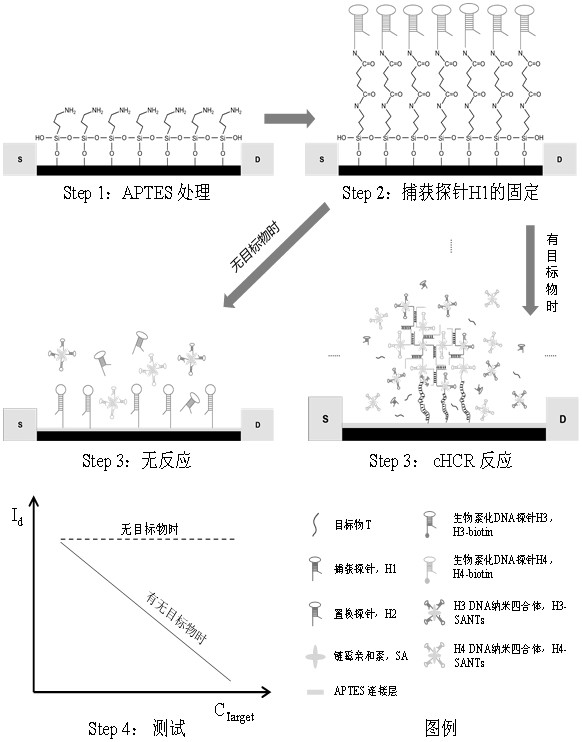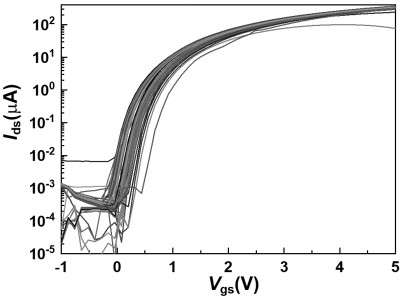Indium tin oxide field effect transistor biosensor based on DNA nano quadruple and application of indium tin oxide field effect transistor biosensor
An indium tin oxide field, biosensor technology, applied in the directions of microorganism-based methods, microorganisms, biochemical equipment and methods, etc., can solve the problems of high false positive rate, long detection time, and complicated detection procedures in short-sequence detection. Improve nucleic acid hybridization efficiency, high amplification efficiency and strong specificity
- Summary
- Abstract
- Description
- Claims
- Application Information
AI Technical Summary
Problems solved by technology
Method used
Image
Examples
Embodiment 1
[0043] Example 1 Sensitivity Experiment of Indium Tin Oxide Field Effect Transistor Biosensor Based on DNA Nano-quadruplex
[0044] (1) Indium tin oxide field effect transistor (ITO FET) was treated with oxygen plasma, the ratio of argon to oxygen was 4:1, the power was 15 W, and the treatment was 2 min.
[0045] (2) Add the APTES solution to the ITO FET treated with oxygen plasma; the concentration of APTES is 5wt%, the solvent is a mixture of absolute ethanol and acetic acid, the content of acetic acid is 10vol%, and the pH value is 5. React at room temperature for 6 hours; after the reaction, clean the ITO FET with absolute ethanol and deionized water; blow dry with nitrogen, and bake at 110°C for 30 minutes.
[0046] (3) Prepare 25 μmol / L hairpin structure DNA solutions H1, H2, H3, H4 and streptavidin (SA) solution with 1×PBS buffer solution with pH=7.4, and refrigerate at 4°C for later use.
[0047] (4) Streptavidin (SA) solution was mixed with hairpin structure DNA H3 s...
Embodiment 2
[0053] Example 2 Indium Tin Oxide Field Effect Transistor Biosensor Based on DNA Nano-quadruplex
[0054] (1) Indium tin oxide field effect transistor (ITO FET) was treated with oxygen plasma, the ratio of argon to oxygen was 2:1, the power was 10 W, and the treatment was 10 min.
[0055] (2) Add the APTES solution to the ITO FET treated with oxygen plasma; the concentration of APTES is 5wt%, the solvent is a mixture of absolute ethanol and acetic acid, the content of acetic acid is 1vol%, and the pH value is 6. React at room temperature for 4 hours; after the reaction, clean the ITO FET with absolute ethanol and deionized water; blow dry with nitrogen, and bake at 120°C for 30 minutes.
[0056] (3) Prepare 20 μmol / L DNA solutions H1, H2, H3, H4, and streptavidin (SA) solution with 1×PBS buffer solution with pH=7.4, and refrigerate at 4°C for later use.
[0057] (4) Mix 20 μmol / L streptavidin (SA) solution with biotinylated DNA probe (H3 / H4) at a ratio of 1:4, and react for 1...
Embodiment 3
[0061] Example 3 Indium Tin Oxide Field Effect Transistor Biosensor Based on DNA Nano-quadruplex
[0062] (1) Indium tin oxide field effect transistor (ITO FET) is treated with oxygen plasma, the ratio of argon to oxygen is 5:1, the power is 50W, and the treatment is 6 minutes;
[0063] (2) Add the APTES solution to the oxygen plasma-treated ITO FET; the concentration of APTES is 2wt%, the solvent is a mixture of absolute ethanol and acetic acid, the content of acetic acid is 5vol%, and the pH value is 6. React at room temperature for 6 hours; after the reaction, clean the ITO FET with absolute ethanol and deionized water; blow dry with nitrogen, and bake at 115°C for 45 minutes;
[0064] (3) Prepare 50 μmol / L DNA solutions H1, H2, H3, H4, and streptavidin (SA) solution with 1×PBS buffer solution with pH=7.4, and refrigerate at 4°C for later use;
[0065] (4) Streptavidin (SA) solution and biotinylated DNA probe (H3 / H4) were mixed at a ratio of 1:4, and reacted for 15 minutes...
PUM
 Login to View More
Login to View More Abstract
Description
Claims
Application Information
 Login to View More
Login to View More - R&D
- Intellectual Property
- Life Sciences
- Materials
- Tech Scout
- Unparalleled Data Quality
- Higher Quality Content
- 60% Fewer Hallucinations
Browse by: Latest US Patents, China's latest patents, Technical Efficacy Thesaurus, Application Domain, Technology Topic, Popular Technical Reports.
© 2025 PatSnap. All rights reserved.Legal|Privacy policy|Modern Slavery Act Transparency Statement|Sitemap|About US| Contact US: help@patsnap.com



